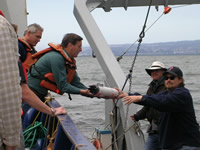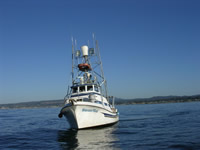


|
The Project
|
September 2, 2005
The Nature of Science One has to wonder why anyone would be interested in thin layers of plankton in the ocean. What were the steps taken in the process of getting a shipload of people and supplies out to Monterey Bay for nearly a month? Where will the information go when we are done? This all has to do with the nature of science. Scientists ask questions about what we know about the world around us. Every time a new or unexpected observation is made, scientists ask how that observation fits with the current understanding of “how things work” in nature. If the new observation doesn’t fit this understanding, then the scientist begins to ask questions. Is the observation reasonable? Did the instrument that made the measurement work correctly? Is this new finding seen more than once or twice? Do these observations require us to change our view of “how things work”? Questions like these were asked by oceanographers when thin layers of plankton were observed during ocean experiments in the late 1980s and early 1990s. The use of new types of instruments allowed more data to be collected. The observations of thin layers of plankton did not fit into the existing ideas about plankton distributions and the mixing of the upper ocean by currents. Over the past ten years, several teams of scientists collected more information about thin layers. These additional results supported the idea that a major oceanographic experiment would help answer some of the questions asked about plankton layers. In 2004, the Office of Naval Research (ONR) provided money for a five-year study of thin layers (called Layered Organization of the Coastal Ocean, or LOCO). Many different teams of scientists submitted research ideas and plans to ONR and a few of those teams were awarded grants to conduct the research. The LOCO scientists then had meetings to discuss where to do the experiment and how to organize the many different types of measurements. Some work would be done from larger research vessels (the RV New Horizon and the RV Robert Gordon Sproul, both from Scripps Institution of Oceanograpy), while other work would be conducted using moored instruments (instruments attached to an anchor, but floating above the anchor). Several smaller vessels would be used to take care of the instruments on the moorings during the experiment. By the fall of 2004, the experiment had been planned for Monterey Bay in August 2005. Each team then began organizing equipment and supplies for the experiment. New instrument systems were built and tested. Finally, truckloads of equipment were sent to Monterey Bay for the moored experiment, while other equipment had to be sent to San Diego to be loaded on the RV New Horizon. During the past month the LOCO scientists have collected large amounts of data about the physical, chemical, and biological properties of plankton layers and ocean currents in Monterey Bay. The science teams will spend the next several months going through their observations and exchanging their observations with the other LOCO scientists. After the results are checked and discussed, the scientists will write articles about the results of the work in Monterey Bay. These scientific articles usually are published in scientific journals that can be found in college and university libraries. Next February many of the teams will present project results at a large meeting of oceanographers from many different countries. It is through the discussions at large meetings and through publication of scientific articles that other scientists will learn of the experiments conducted by the LOCO team. Scientists then will look carefully at the results of the thin layer studies from Monterey Bay and ask new questions about any observations that don’t fit their understanding of “how things work.” New experiments might be planned to answer those new questions that popped up once the LOCO results were evaluated. This is the normal progress of science – ask questions, conduct experiments, evaluate results, ask new questions, and so on. This process of questioning and testing is key to doing science – it is often called the nature of science. This is just what the scientists in the LOCO project have been doing, so that the results might improve our understanding of the ocean.
|


